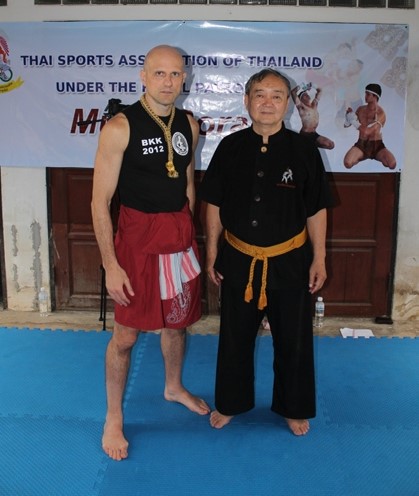
Exclusive interview with Muay Thai Grand Master Chaisawat Tienviboon.
by Marco De Cesaris
Grand Master Chaisawat Tienviboon has spent almost 60 years studying the principles of Muay Thai back to the roots of the Art. He started to teach Muay in 1968 at Chulalongkorn University. In the course of his research about ancient Muay, he found that over the centuries some important techniques and fighting principles had been forgotten and disappeared from modern practice. Therefore, he tried to restore those missing parts, bringing Muay Thai techniques back to their original efficiency. He also combined, as it was the ancient custom, bare handed fighting with the use of weapons, blending both skills into a modern-traditional style. At present he is Head of Curriculum Design Working Group of the Muay Thai Strategy Subcommittee appointed by the Thai Ministry of Tourism and Sport. In this exclusive interview for Budo International, Arjarn Chaisawat talks about the years of his apprenticeship, the origins of his style and reveals a lot of fascinating details about some of the greatest masters of Muay, for the first time.
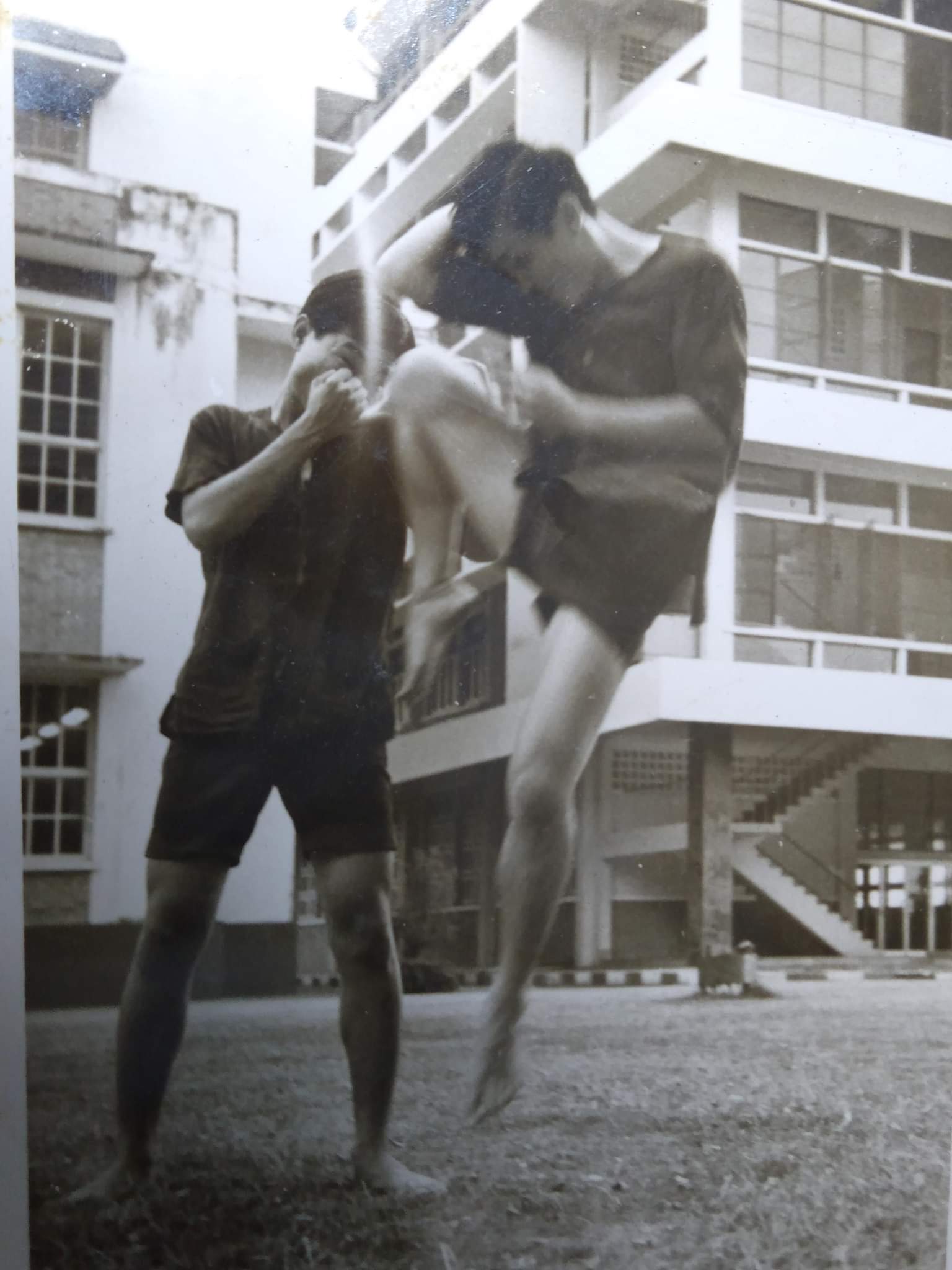
Q1. Arjarn Chaisawat, could you tell us about the years you spent studying Muay? How did you begin?
A1. In 1962 I was attending high school in Chiang Mai, 100 km away from my hometown Lampang. At the school’s gym I saw some of my classmates punching and kicking the hanging bag. I liked that very much, it seemed so beautiful to me. Then I tried to kick and punch the heavy bag, too. But the result was very bad. Actually, we all tried to do some Muay copying from other fellow students; there was no formal teaching at all. During school holidays I went back home to Lampang. I told a close friend of mine, Tawee, that I wanted to learn Muay Thai because I knew that Tawee’s father, Khru Roj, was a famous Muay Thai teacher. Therefore, Tawee brought me to ask his father to accept me as one of his students. That year I started to learn Muay from Khu Roj. Every school holiday I went to learn Muay with him. It took me six years to reach a good level.
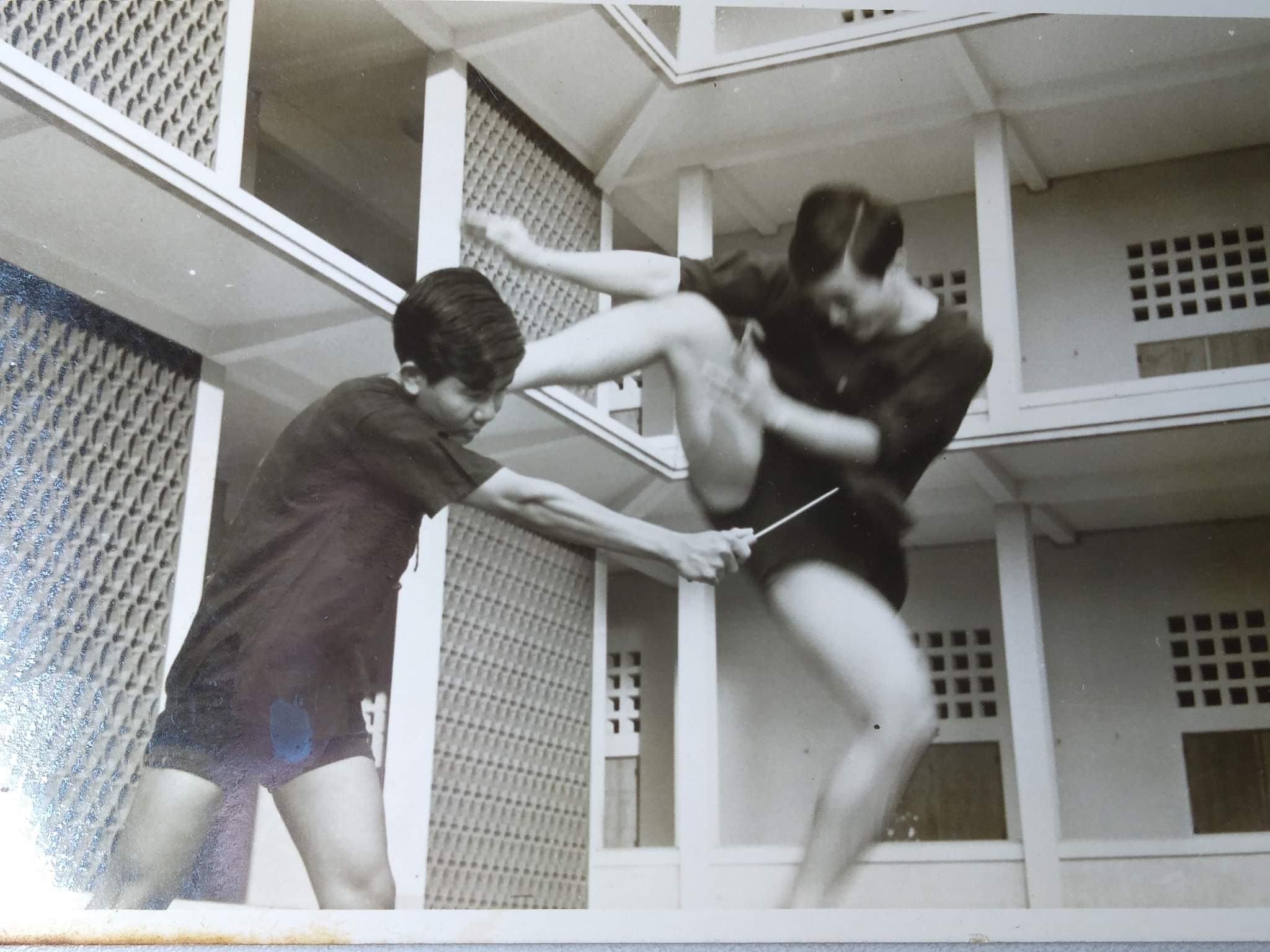
Q2. I know you studied under some legendary Masters of Muay. Can you tell us about Master Taweesit’s (1890-1961) style of Muay?
A2. Arjarn Soontorn (Kimseng) Taweesit was the founder of Muay Taweesit. Muay Taweesit was a Modern-Traditional style of Muay at the beginning of 20th century. In fact, the core of Arjarn Taweesit’s style was a combination of traditional Muay he learnt from his master, Khru Khiao (green in Thai language), and western Boxing’s principles and techniques that he learnt from a boxing coach named Mr. Baker. At that time, Muay Thai Boran didn’t include straight punching (Jab and Cross) typical of western Boxing.
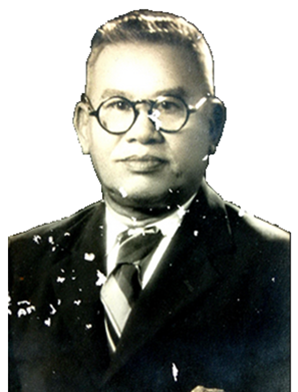
In fact, traditional Muay came from Thai fencing and punching techniques in particular came from Dap (the typical short Thai sword) maneuvers. Therefore, punches were mainly swings. Moreover, in Muay Taweesit syllabus some throwing and joint breaking techniques taken from Ju Jitsu were also included. I didn’t have a chance to learn directly from Arjarn Soontorn Taweesit, but I am his third generation student. In fact, Arjarn Soontorn is Arjan Sutin’s teacher. Arjarn Sutin is Arjarn Roj’s teacher and Arjarn (Khru) Roj is my teacher. I am in Arjarn Taweesit lineage.
Q3. And what about your teacher, Arjarn Roj Chaijak?
A3. Roj Chaijak or Khru Roj was one of the best Muay Thai boxers of his time. He had many students: among them was one the first Champion of Thailand at that time. One of his student was also Arjarn Chaisawat Tienviboon. I remember that Khru Roj was very strict in teaching. He allowed no deviation from the standard. If one of his student couldn’t perform the technique he taught one day in class, the next day that same student wasn’t allowed to progress to a more advanced technique. This went on until the student wasn’t perfectly proficient at performing that maneuver. Therefore, it took Arjarn Chaisawat six years to learn Look Mai techniques.
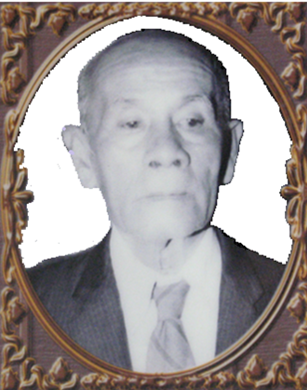
Q4. You studied also the style of renowned Master Ketr Sriyapai (1902-1978): can you tell us about him?
A4. Khru Ketr Sriyapai is widely recognised as the great master of Muay Chaiya, the style of Muay of Southern Thailand. However, Khru Ketr belonged to two lineages of Muay. One lineage was the style of his family which he called Muay Chaiya or Muay Choa Chaiya. His Muay Chaiya teacher was his father, Provincial Ruler of Chaiya. The other lineage which Khru Ketr belonged to was Muay Taweesit. In fact, Khru Ketr Sriyapai was Khru Soontorn Taweesit’s student and he was also good friend of Khru Sutin (Khru Sutin is Khru Roj’s teacher and therefore is my teacher’s teacher). Therefore, Khru Ketr and myself belong to the same Muay Taweesit lineage.
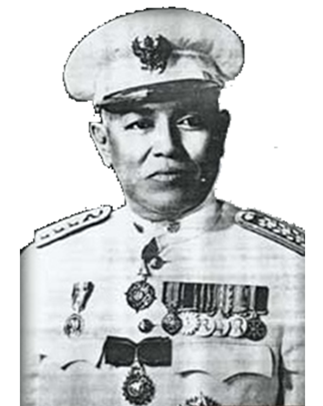
My personal acquaintance with Khru Ketr started when I read an article he wrote for a Muay Thai Magazine in which he talked about an event which occurred in King Rama VI period (1909-1924). At that time the Thai Government provided monetary funds for the Boy Scouts. In order to get the money for the Boy Scouts, the Government asked each city to send its best boxers to fight in Bangkok. In those fights, most of Thailand’s best fighters lost to Muay Taweesit students. When I read that article I decided to write a letter to Khru Ketr and asked the permission to learn Muay Taweesit from him. Khru Ketr accepted and came to Chulalongkorn University to teach me and my students Muay Taweesit. Therefore, Khru Ketr taught me Muay Taweesit style and afterwards he also taught me his Muay Chaiya.
Q5. We can say that you are the link between the old generations and the modern practitioners. In your opinion, what are the differences between the two?
A5. Old generation of Muay Boran practitioners learnt the Art for real fighting. Muay Boran fighting was “all-out combat”. There was no rule. In learning Muay Boran a modern student must try to learn every detail of each technique he is taught and must try to study all aspects of each maneuver in depth. In fact, he needs to trace back the original roots of all Mai Muay he practices, all the time.
Modern Muay Thai boxing practitioners learn Muay for the sport. They train because they want to build their sport career. In order to perform well in the ring and build a successful professional career (especially in Thailand) they have to display beautiful techniques when they fight. At the same time they don’t aim at seriously hurting their opponents.
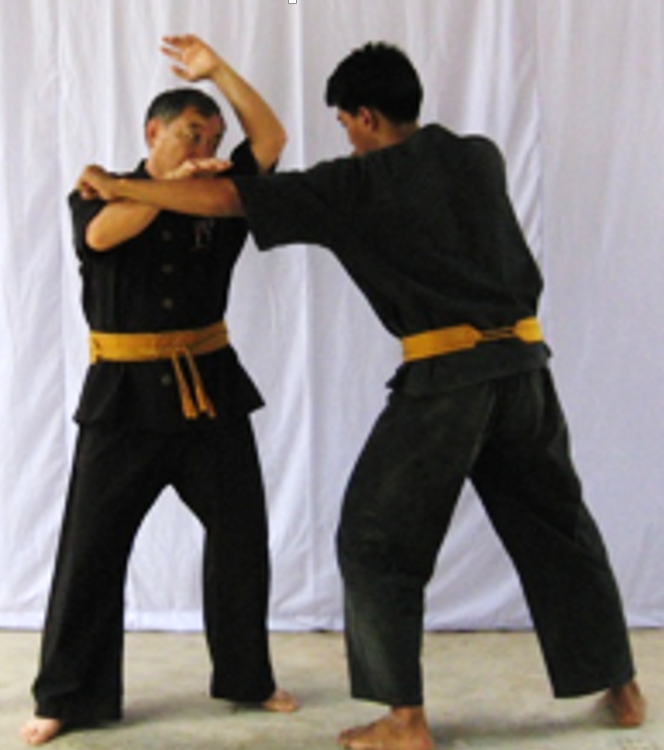
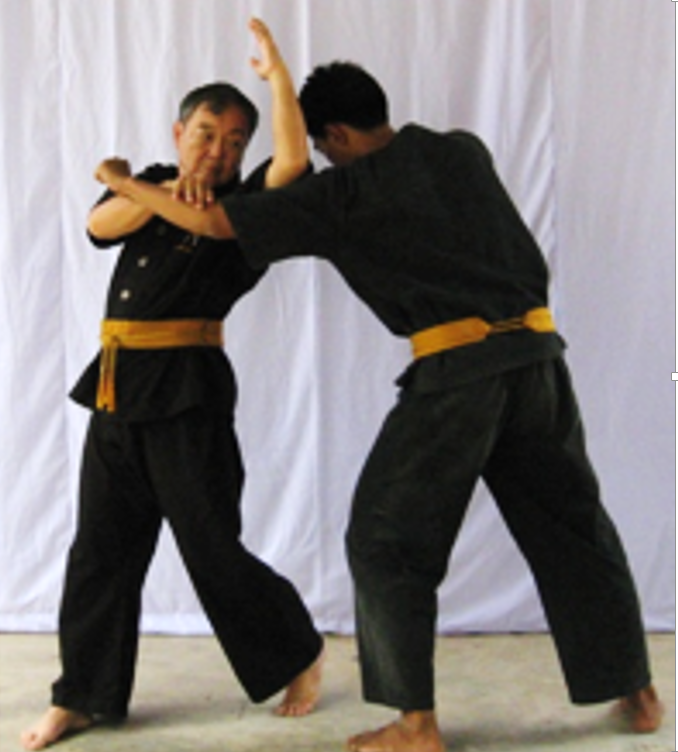
Q6. You often say that “if you compare Muay Thai principles with a picture, the picture you have received was partially damaged”. Can you explain this statement?
A6. All human beings have the same physical structure with two arms and two legs, from the beginning of time. Ancient people, all over the world, developed the fighting techniques that we still practice today. However, some principles and techniques were not properly transferred from generation to generation and were lost in time. Moreover, some masters who developed fighting skills along the centuries decided to keep those skills secret and never showed them publicly.
This is what I believe. Therefore, I always compare the skills I have learned to a picture that was partially damaged. Along the years, I tried to bring the Siamese fighting skills to their original completeness to the best of my ability.
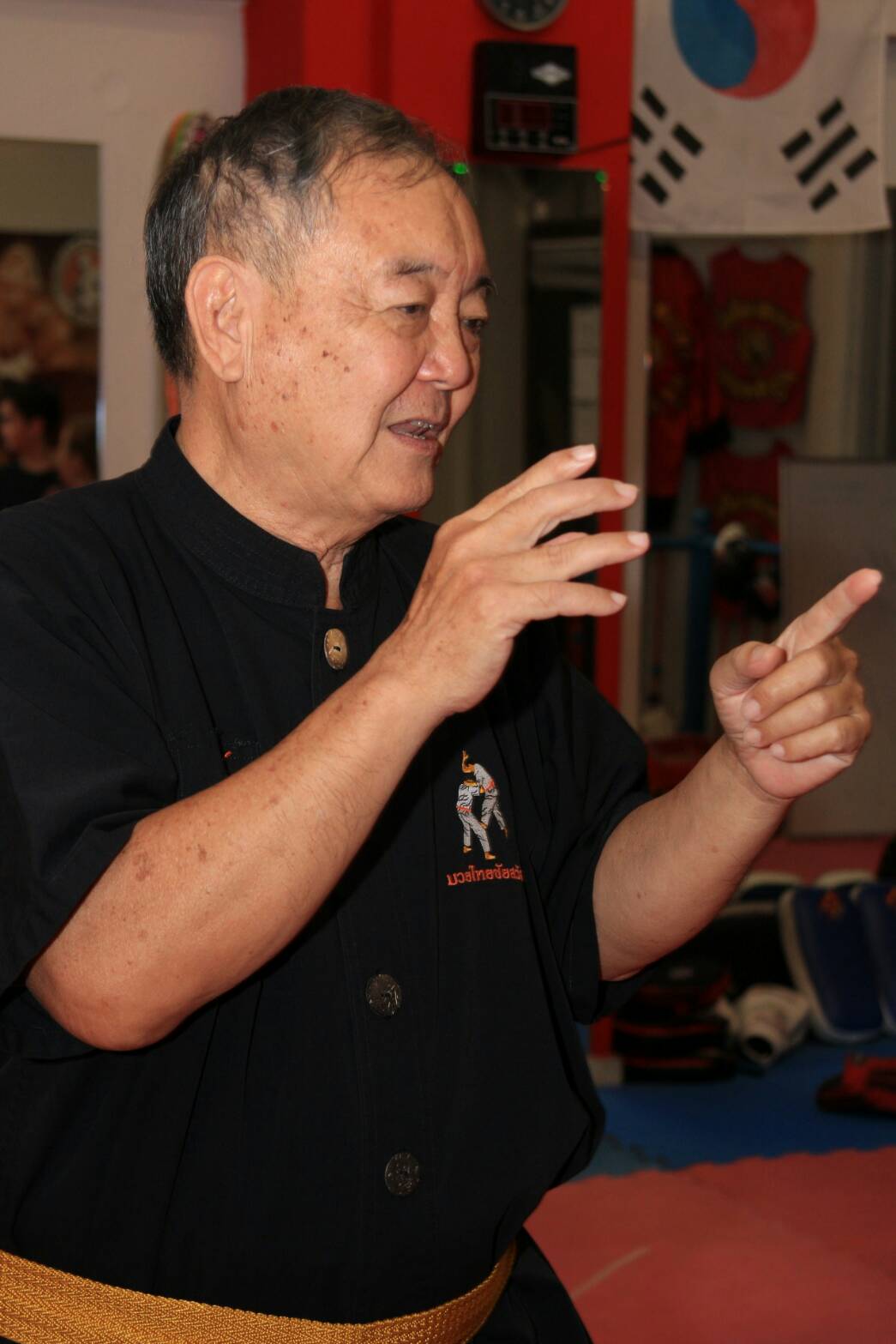
Q7. Your style is considered a modern-traditional style. What does this mean?
A7. The core of a modern traditional style of Muay is traditional Muay Thai or Muay Boran. This strong base is combined with the best technical elements of any martial art style from all over the world. This elements are useful to overcome the weak points of traditional thai fighting arts. The result will improve Muay for future generations. Therefore, in Muay Chaisawat some principles and techniques from Japanese Aikido are included in the standard syllabus.
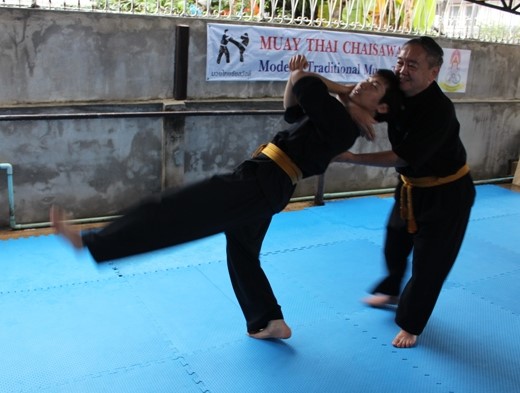
Q8. What are the main technical features of Muay Chaisawat?
A8. The main technical features of my style are the following 3 fighting principles: Escape, counter attack, follow up.
Escape or Lop Lik is the main defensive strategy of all styles of Muay. If you employ this strategy, you can dodge the attack and keep a safe position, out of range of the opponent’s body weapons. Otherwise, you can escape inside the attack. This means that you are in the range of the opponent’s body weapons. In this situation you must be aware of the attacker’s second stroke and you need to counter attack quickly. Counterattacks (Tob To) are best executed when you are in the safe position, that is on the outside of the line of attack. When you evade the attack and you counter simultaneously, without blocking or parrying, you are using the Pun Lum strategy. This is the most advanced and safe counter fighting system in Muay.
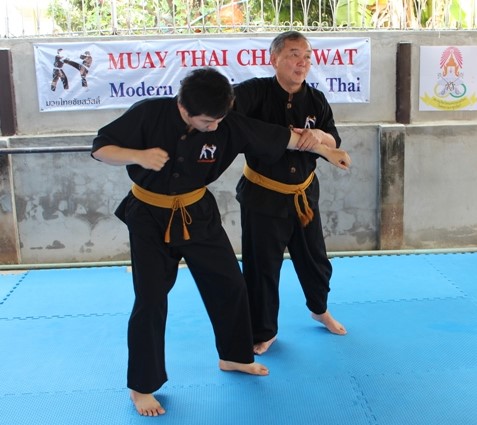
Remember to always pursue (Tid Tam) the opponent after the first counter, with follow up counter attacks, exploiting his loss of balance, until he is defeated.
Talking about defense: blocking and parrying (Pad Pong) should be used only as a last resource. In fact, whenever you are in range to apply a block, you are also in range to execute a counter attack. If you use that split second to block the opponent’s attack, you miss the chance to counter strike. Attacking is superior to blocking as far as defense is concerned.
Q9. In your opinion, what is the relationship between Traditional Muay and modern Thai Boxing?
A9. When we make a comparison between the techniques of Muay Boran and the techniques of modern Muay Thai, it is evident that some Muay Boran maneuvers cannot be used in Muay Thai because they are potentially too dangerous for sport fighting. I’ll make an example to clarify the difference. When the opponent attacks you with a roundhouse kick to the body or head, you can counter with a kick to the supporting leg. In order to do that, you can apply the maneuver called Taye Kham Sao: a low side kick aimed at the opponent’s supporting knee.
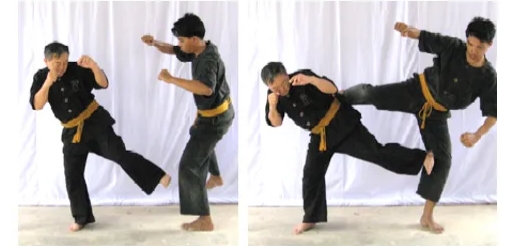
Otherwise, the high swing kick can be countered with a low swing kick aimed at the calf or back of the leg of the attacker. This Mai Muay is called Thaen Kwad Laan.
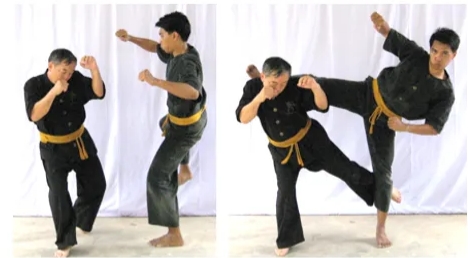
Both techniques rely on the same counter-fighting principle. Both techniques are equally fast. However, the first, Tayae Kham Sao, can be used only in a real fight: in fact, it cannot be used in a professional Muay Thai contest because, if properly applied, this counter-attack can cripple a boxer. The sport career of a Nak Muay could be dramatically cut short. On the other hand, the second Mai Muay, Thaen Kwad Laan, is actually used by all professionals in sport Muay Thai. In fact, it is a very efficient counter-attack that, if properly applied, leads to a spectacular throw but doesn’t hurt the attacker too much.
All in all, traditional Muay Thai and modern Muay Thai have the same root. The difference lies in the aim of learning. Currently, the first aim of someone who learns traditional Muay Thai is to use it in real life (self-defence). On the other hand, the ones who learns sport Muay Thai wishes to use it in sport, often to build up a professional career. All things considered, the one who truly loves Muay Thai (traditional or modern) will always try to find the real root of his Martial Art and try to keep alive the culture it came from.
Q10. What would you suggest to a western student of Muay Boran who really wants to reach the core of this Martial Art? (Arjarn Chaisawat, an extremely open minded Thai Grand Master, has shared with me several times his thought about the real nature of Muay: is it exclusively a Thai cultural heritage or can it be considered a World heritage, nowadays?)
A10. Everybody can learn Muay Boran. Everybody can learn Muay Thai. The one who was born and raised within Thai culture is advantaged. However, he who was not born in Thailand but really wants to learn and works hard, can reach the same level, some day.
Thank you very much, Arjarn Chaisawat. Your words are a true source of inspiration.

